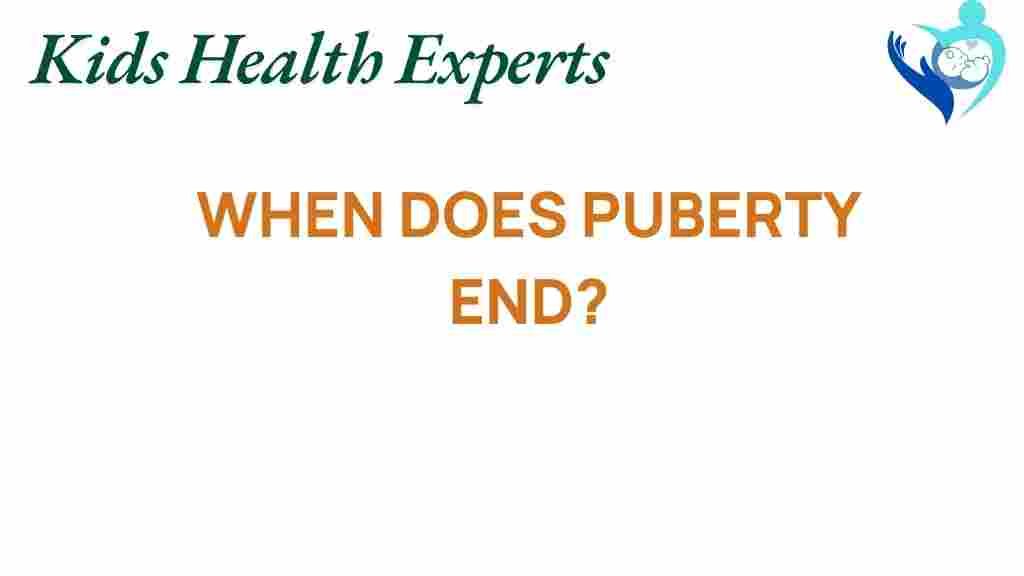Unraveling the Mystery: When Does Puberty Truly End?
Puberty is a significant period in human development, marking the transition from childhood to adulthood. It involves a series of complex hormonal changes that lead to physical, emotional, and psychological transformations. Understanding when puberty ends can provide clarity on growth milestones and the overall development process during adolescence. This article aims to explore the stages of puberty, its duration, and the various changes that occur throughout this vital phase of life.
What is Puberty?
Puberty is a biological process characterized by a series of changes that prepare the body for sexual maturation and reproductive capabilities. While the onset of puberty typically occurs between the ages of 9 and 14 for girls and 10 and 15 for boys, the exact timing can vary significantly among individuals.
The Stages of Puberty
Puberty is generally divided into several stages, often referred to as Tanner stages, which outline the physical development during this period. Here’s a brief overview:
- Stage 1: Prepubertal – Characterized by no visible signs of puberty.
- Stage 2: Early Puberty – Initial signs of growth; in girls, breast development begins; in boys, testicular enlargement occurs.
- Stage 3: Mid-Puberty – Continued physical changes; girls may experience menarche, and boys see increased muscle mass and body hair.
- Stage 4: Late Puberty – Most physical changes have occurred, but full maturity is still developing.
- Stage 5: Post-Puberty – The individual reaches full adult physical form; secondary sexual characteristics are fully developed.
Hormonal Changes During Puberty
Central to puberty are the hormonal changes that drive physical development. The hypothalamus signals the pituitary gland to release hormones, which in turn stimulate the gonads (ovaries in girls and testes in boys) to produce sex hormones:
- Estrogen – Predominantly in females, responsible for breast development and regulating the menstrual cycle.
- Testosterone – Predominantly in males, responsible for muscle growth, voice deepening, and increased body hair.
These hormonal changes also influence emotional and psychological development, contributing to the distinct experiences of adolescence.
Physical Changes During Puberty
As puberty progresses, several physical changes are evident:
- Growth spurts: Significant increases in height and weight.
- Development of primary and secondary sexual characteristics: For girls, breast development and the onset of menstruation; for boys, testicular and penile growth.
- Changes in body composition: Increased muscle mass in boys and increased body fat in girls.
- Development of body hair: Pubic hair and underarm hair begin to appear.
Emotional Changes During Puberty
Along with physical changes, puberty brings about notable emotional changes. Adolescents may experience:
- Increased mood swings and emotional sensitivity.
- A stronger desire for independence and self-identity.
- Heightened social awareness and peer influence.
- Exploration of romantic relationships.
These emotional fluctuations are often attributed to the interplay between hormonal changes and social dynamics during adolescence.
How Long Does Puberty Last?
The duration of puberty can vary widely among individuals. Generally, puberty lasts about 4 to 6 years, but it can start as early as age 8 and end as late as the early 20s. Understanding the timeline is crucial for recognizing developmental milestones:
- Girls: Puberty typically starts between ages 8 and 13, with menarche occurring around ages 11 to 14. Most girls reach full maturity by ages 16 to 18.
- Boys: Boys often start puberty later, usually between ages 9 and 14, with most physical changes completing by ages 17 to 19.
Milestones of Development During Puberty
Throughout puberty, there are several key milestones that indicate progress in growth and development:
- For girls: The onset of menstruation, breast development, and mature body shape.
- For boys: Testicular enlargement, deepening of the voice, and increased muscle mass.
Each individual may experience these milestones at different times, making it essential to understand that there is no “one size fits all” timeline for puberty.
Factors Influencing the Duration of Puberty
Several factors can influence how long puberty lasts, including:
- Genetics: Family history can play a significant role in the timing and duration of puberty.
- Nutrition: Adequate nutrition can foster healthy growth, while malnutrition may delay the onset of puberty.
- Health Conditions: Certain medical conditions or hormonal disorders can impact the duration and progression of puberty.
- Environmental Factors: Stress and socio-economic conditions can also influence the timing of developmental milestones.
Troubleshooting Common Concerns During Puberty
As adolescents navigate puberty, various concerns may arise:
- Delayed Puberty: If an adolescent has not shown signs of puberty by age 14 for girls and 15 for boys, it may be advisable to consult a healthcare professional.
- Rapid Changes: Sudden growth spurts or emotional fluctuations can be overwhelming. Open communication with trusted adults can provide support.
- Body Image Issues: Adolescents may struggle with self-esteem due to body changes. Encouraging positive self-image and body positivity can help.
It’s important for parents and guardians to provide guidance and reassurance during this tumultuous time.
Conclusion: Understanding the End of Puberty
In conclusion, understanding when puberty ends is crucial for grasping the overall growth and development of adolescents. While puberty may generally last from ages 10 to 18, it can extend into the early 20s for some individuals. Throughout this journey, hormonal changes, physical changes, and emotional changes shape the experiences of young people.
By recognizing the various milestones and factors influencing puberty, we can better support adolescents as they transition into adulthood. To explore more about the stages of development, feel free to visit our developmental resources.
For deeper insights into the biological aspects of puberty, you may find this external resource valuable.
Ultimately, understanding puberty is not just about knowing when it ends; it’s about appreciating the profound transformations that shape our lives from childhood to adulthood.
This article is in the category Growth and created by KidsHealthExperts Team
